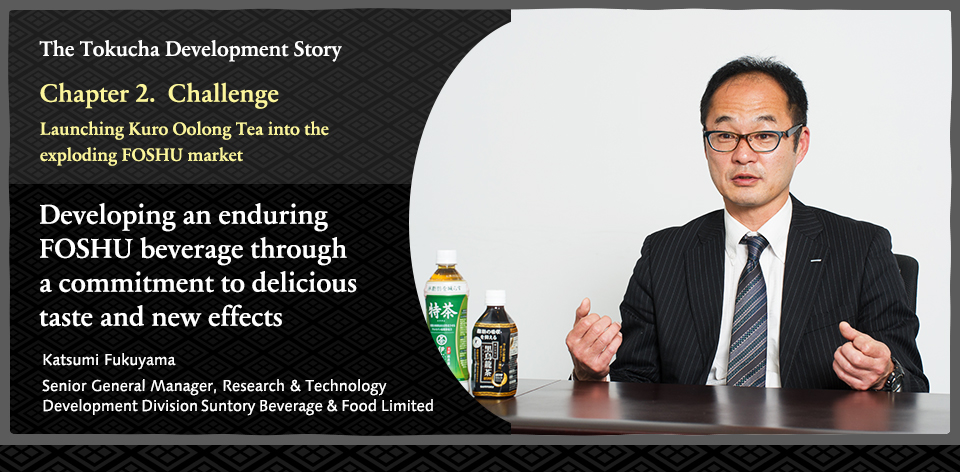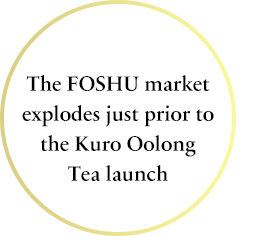- Suntory Global Innovation Center
- > Research & Technology
- > The Tokucha Development Story
- > Chapter 2. Launching Kuro Oolong Tea into the exploding FOSHU market
Research & Technology

Our company began its all-out efforts to develop FOSHU products in 2002 with the launch of a special project team charged with developing products that would link health and food and generate new Suntory business.
When we consider health in the context of food, we need to go beyond the idea of simple nutrition and focus on what might be called a tertiary function of food: regulating physical functions. It is important that people take good care of themselves day in and day out in order to prevent their health from worsening. Since Foods for Specified Health Uses were the most direct way to achieve this, we were sure that the market for them would be huge. Convinced of our reasoning, our project team submitted a report to management in the hopes of launching a set of serious FOSHU initiatives.
In developing FOSHU products, naturally we needed to produce clear scientific evidence identifying (1) the components that would enter the body upon consumption and (2) the function of those items as well as their efficacy in producing results. The project team began by thoroughly reinvestigating the health data that Suntory had accumulated over its years of work in polyphenol science, and building up its case from within that framework.
In working with FOSHU products, we first had to discuss the scope of our aims. We came to the conclusion that the most pressing health concern that the Japanese faced was body fat. Obesity leads to a host of medical problems, and is intimately tied to food. The number of people who have this concern—which includes those at risk for obesity—is truly substantial. We were certain that the demand was there.

We set our sights on the research findings on oolong tea polyphenols that Suntory had accumulated over the years. Suntory Oolong Tea was already one of the company’s mainstay products, and we were convinced that we would be on the right track if we could establish evidence for its health benefits.
We did not want to simply prove that oolong tea effectively promoted weight loss. Because FOSHU designation signifies approval from the national government, the average consumer sees them in a different light. With that goal in mind, we began working to develop a dark oolong tea product and successfully apply for FOSHU certification.
Though the FOSHU program had been around since 1991, it had not yet really entered the consumer consciousness. Public attention was shifting, however, as other companies were launching a variety of health-oriented products. When some of them hit big, the FOSHU market began to grow.
A year after we had set up our project team, another company beat us to the punch by releasing a FOSHU product in the same obesity-fighting category as our Kuro Oolong Tea. We were now trailing behind, but we didn’t panic. We knew it would take time to identify a previously unknown mechanism of this new OTPP component, and to reliably confirm its functionality and safety. We knuckled down and got to work.
The most important thing was presenting solid data that proved the efficacy of OTPP. We also knew that the innovative way OTPP worked—by blocking the absorption of fats into the body—would help make our product fresh and attractive.

Suntory began discussing ways to set our product apart from the similar item already being offered by a competitor, concentrating on the fact that we were working from a different angle. Though both FOSHU products were intended to combat obesity, ours functioned by different mechanism; namely, while the existing product was touted as “fat-burning,” our dark oolong tea worked on the concept of blocking fat absorption.
 Fats are made up of a combination of three fatty acids. If they cannot be broken down into these components, the body cannot absorb them. OTPP works by inhibiting the lipase enzyme that breaks down fats, thereby preventing them from being absorbed into our systems.
Fats are made up of a combination of three fatty acids. If they cannot be broken down into these components, the body cannot absorb them. OTPP works by inhibiting the lipase enzyme that breaks down fats, thereby preventing them from being absorbed into our systems.
In addition, our dark oolong tea was unexpectedly mellow and easy drinking despite its almost black color. FOSHU products by definition contain health-promoting ingredients, which typically have some effect on flavor. OTPP, however, is more similar to a pigmentation ingredient—so while it has a significant effect on coloring, it does almost nothing to alter the taste of the product. This meant that we could put out a FOSHU product that was also delicious and readily enjoyable.
Because we are a soft drink company, we essentially want to quench our customers’ thirst with beverages that are both delicious and good for you. Despite the old Japanese adage that “good medicine is bitter medicine,” people find it difficult to continue using something day after day if it tastes bad. We took this concept into our later efforts to develop Tokucha as well.
Though some of us questioned whether the tea was too dark, we decided that the blackish color offered proof that it was packed with health-promoting ingredients, and decided to go with the name Kuro (black) Oolong Tea. It took two years to secure FOSHU approval, and four years after we first came up with the product concept, Kuro Oolong Tea finally hit the shelves.
It was no surprise that what we struggled most with during the development process was the fact that we had to identify which of the numerous oolong tea polyphenols were active ingredients and then demonstrate their efficacy. The term “oolong tea polyphenols” covers a truly vast variety of components—so many that we don’t even know how many there actually are. Identifying which of them are actively working may seem like a dull task, but it was one that required a tremendous amount of energy, perseverance, and even luck.
When drunk with a meal, Kuro Oolong Tea effectively cuts the rise in neutral fats in the body after eating by 20%, nearly doubling fat excretion. It is also delicious and easy drinking. Thanks to these properties, our dark oolong product was a huge hit, shattering the ten-million-case sales mark just a year after being launched.
We think our success came largely from the fact that the new tea met consumer expectations in terms of great taste—in addition to the fact that existing trust towards our Suntory Oolong Tea created a significant tailwind. The concept was simple as well—oolong tea’s reputation for having slimming qualities was now solidly backed by science. All of these factors undoubtedly contributed to the great success of Kuro Oolong Tea.

* The department name, title, and photo are as of the time of the production (interview).
* The department name, title, and photo are as of the time of the production (interview).











